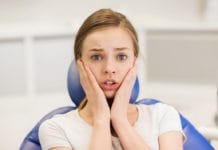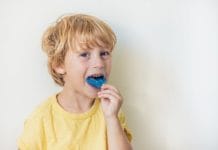It is estimated that 30 million Americans are exposed to potentially harmful sounds at work. Many workplaces require hearing protection devices (HPD) as personal protective equipment (PPE). Dentists and their auxiliaries are regularly exposed to decibel (dB) levels at and above the level of 85, which begins an unsafe zone for ears without protection. Awareness needs to be generated within the dental sector regarding noise-induced hearing loss (NIHL) sooner rather than later. According to Johns Hopkins Medicine, adults age 21-60 years of age should have a hearing baseline test, then an annual re-evaluation.7 Without a campaign to educate the overall population, let alone, the dental industry, many dental personnel will continue their daily endeavors without understanding preventive methods to protect against NIHL. HPDs are available for the dental industry; however, considering the lack of “push” for their usage, there is an unfamiliarity.
For years in the dental profession, there’s been a buzz about PPE.
Lab coats, eye protection, gloves, and masks are repeatedly mentioned throughout Occupational Safety and Health Administration (OSHA) classes. Why aren’t HPDs mandatory pieces of PPE? With compiled uses of various noises throughout dental work environments, including high-speed handpieces, high and low-speed suction and ultrasonic scalers, dental personnel are at a potential high risk for hearing loss. With this knowledge, it is important that dental professionals begin baseline hearing tests and learn what types of HPDs are available. Much like there is focus on dental prevention for dental patients, there must be a recognition in the causes of NIHL in the dental profession and accountability to understand that preventive methods are necessary for longevity in maintaining optimum hearing.
Discussion
OSHA mandates that employees wear HPDs with exposures to 85 dB or higher for eight continuous hours.11 Within the dental community, generally there are not eight continuous hours of noise levels at or above 85 dB, rather exposure to repeated smaller bursts of noises over time, therefore it is not mandated by OSHA that dental personnel wear HPDs. A Study by Lehto explains, “Even if noise exposure in the office is minimal, the potential for noise-induced hearing loss exists.”8 With ten million Americans affected by NIHL, it is now seemingly vital that the dental community pays attention.5 Recognition should be directed to the amount of noise in which the dental professional is exposed; it may depend on the type of treatments that are scheduled and the type of equipment used, whether it is an older high-speed handpiece or an ultrasonic scaler.9
In addition to the daily noises, there are many other exposures outside the dental office, that may influence the potential for risk for NIHL. Asha.org cites that many recreational activities can contribute to NIHL.10 Sixty million Americans own firearms, and many are not using appropriate protection devices.10 What a mind-boggling fact, considering a rifle registers at 160 dB! In addition, jacks for stock car racing resister at 130 dB, MP3 players can reach 110 dB, and hand drills register at 100 dB. While these are only a few examples of outside noises, there should be recognition that dental personnel likely increase their level of risk to NIHL when adding additional noises to the already accumulated noises they are constantly exposed to within their work environments.
Handpieces are one of the main sources of noise within the dental office. A review of the history of handpieces can lend a perspective to their role in the potential for increasing NIHL and also aiding to decrease this condition. According to Cantwell, “Beginning in the 1950’s quieter belt-driven drills were replaced with air-driven hand drills, that registered above the recommended dB level of 84.”3 It was also noted in the Cantwell study, that although there were noted shifts in the threshold amongst dentists, there was nothing conclusive to show the newer handpieces were a hazard to hearing. A similar notion was derived in the 1960’s research, however, Cantwell et al., stated that the possibility of hearing loss cannot be discounted. Louder ultra-high-speed drills were introduced in the 1970’s, producing dB of over 100, which is well above 85 dB.5 With this statistic in mind, there was an indication that there could be a possibility of auditory damage from extended exposure to these devices. Per Cantwell, “In the 1980’s and 1990’s, the correlation between ultra-high-speed handpieces and NIHL were equivocal. It then became recommended that ear protection and audiological follow up become a practice for dental professionals.”3
Not only must handpieces be considered in the dental setting, but it should also be noted that other sounds, which are thought to be of minimum consideration such as a saliva ejector against soft tissue and high-speed suction register at 72 and 75 dB, respectively. Along with a higher decibel spectrum, various types of ultrasonic scalers range from 83 to 107 Db.6 With this in mind, there is an imminent need for dental hygienists to recognize their risk factors for NIHL, which are ten-fold due to the increase in the use of ultrasonic scalers.
Since it is becoming more evident that dental personnel have increased risks toward NIHL, the industry should enlist the services of the audiology industry. Johns Hopkins Medicine recommends, “Every adult should obtain a baseline hearing test between the ages of 21-60.”7 If a potential hearing problem arises, the baseline can give an indication of where a patient lies with their hearing loss. Subsequent tests would be indicated yearly with an annual physical. Not surprisingly, “most people haven’t had a hearing test since grade school.”2
There are two primary types of HPD’s available in the marketplace: 1) active sound control, which allows for vast protection while unsafe noise levels are occurring, yet also allowing for decompression of the HPD while the noise level is safe, therefore allowing the ability to communicate effectively without muffled sounds; and 2) passive noise control, which protects against unsafe noise levels, but does not allow for clear hearing that is needed for effective communication; a muffled sound would be occurring.
While ear protection is the best preventive method for protecting the dental professional’s hearing, not all ear protection is created equally.
Earplugs, which are a passive method of HPD, are the most common device used to protect ears from loud noises. There are many over-the-counter types, which are made of foam, molded polyurethane, and silicone.1 Ultimately, earplugs can protect but do not allow the dental professional to hear his/her patients effectively. Therefore this is an ineffective way to protect one’s hearing while trying to deliver optimum care. Custom earplugs made at an audiologist are the best way to obtain using a passive device. Earplugs can reduce decibel ranges from 25 dB to greater capacities based on their specific noise reduction ratings of N25 to N33, which is a far better outcome than an older, archaic method of putting cotton into the ear, which only reduces levels by 7 Db. A noise reduction rating of N25 has the capacity to reduce the decibel levels by 25, while a noise reduction rating of N33 will have a greater capacity to reduce damaging noise levels.1
As with most things medical, there is an advanced method to protect the ear. The EarAID, an active method of HPD, is a small and adaptable earpiece, powered by a tiny hearing aid battery, which lasts about two weeks. It has a noise reduction rating of N25. When it is worn, the custom electronic circuitry compresses sound when it reaches a dangerous noise level, but stops when safer noise levels are resumed. This is thought to be a smart ear technology since it does the “thinking” for the dental professional, all the while allowing the dental professional to resume normal conversations.4
Conclusion
While working as professionals in the field of dentistry, guiding patients towards methods of prevention for their oral and systemic health statuses, many dental professionals are ignoring a basic preventive method in protecting that which is used daily to understand patient needs; it is the ability to hear. Earplugs, whether passive or active, should become a consideration for PPE for dental professionals. Compounding evidence that illustrates that dental professionals are indeed at risk for hearing loss. It also can be argued that evidence is not compelling enough with hearing loss being linked directly to occupational exposure in dentistry; however low outcome baseline hearing tests in dental professionals should be enough to campaign for awareness within the dental field. It is often heard, “Floss only the teeth you want to keep!” Perhaps audiologists might share a mantra with the dental industry as a reminder, that much like flossing, prevention from an audiological perspective is equally important for dental professionals to consider.
Need CE? Check Out the Self-Study CE Courses from Today’s RDH!
Listen to the Today’s RDH Dental Hygiene Podcast Below:
References
- A call for hearing protection in rural America. https://nidcd.nih.gov/news/2000/call-hearing-protection-rural-america
- org. (2017, September 10). Retrieved from ADA Center for Professional Success: http://success.ada.org/en/wellness/safety-tips-to-avoid-hearing-loss
- Cantwell KR, T. A. (1960). Noise from high-speed hand-pieces. J Am Dent Assn, 571-577
- Dental Innovations LLC. (2017, July 18). Retrieved September 29, 2017, from http://www.dentalinnovationsllc.net/
- org. (2017, September 10). Retrieved from Dangerous Decibels: http://dangerousdecibels.org/education/information-center/noise-induced-hearing-loss/
- Hearing difficulties among experienced dental hygienists: A survey. J Dent Hyg. 2015 Dec;89(6):378-83.
- Johns Hopkins Medicine. (2017, September 10). Retrieved from Otolaryngology: Head and Neck Surgery: http://www.hopkinsmedicine.org/otolaryngology/specialty_areas/hearing/hearing-loss/baseline-testing.html
- Lehto, T. L. (1989). Hearing of dentists in the long run: A 15-year follow-up study. Comm Dent and Oral Epidemiol, 207-211.
- Mervine, Rebecca A. M.-A. (2008). Noise-Induced Hearing Loss in Dental Offices. Dental Academy of CE, 3.
- Noise. http://www.asha.org/public/hearing/Noise/
- UNITED STATES DEPARTMENT OF LABOR. (n.d.). Retrieved December 29, 2017, from http://www.osha.gov/pls/oshaweb/owadisp.show_document?p_table=standards&p_id=9735.












